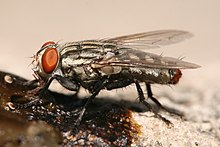
Back ذبابة اللحم Arabic ذبابة اللحم ARZ Sarcophagidae AST Сиви месарки Bulgarian Sarcofàgids Catalan Sarcophagidae CEB Kødfluer Danish Fleischfliegen German Sarcophagidae Spanish مگس گوشت Persian
This article includes a list of general references, but it lacks sufficient corresponding inline citations. (January 2012) |
| Flesh flies | |
|---|---|

| |
| Sarcophaga bercaea | |
| Scientific classification | |
| Domain: | Eukaryota |
| Kingdom: | Animalia |
| Phylum: | Arthropoda |
| Class: | Insecta |
| Order: | Diptera |
| Section: | Schizophora |
| Subsection: | Calyptratae |
| Superfamily: | Oestroidea |
| Family: | Sarcophagidae Macquart, 1834 |
| Subfamilies | |

Sarcophagidae (from Ancient Greek σάρξ sárx 'flesh', and φαγεῖν phageîn 'to eat')[1] are a family of flies commonly known as flesh flies. They differ from most flies in that they are ovoviviparous, opportunistically depositing hatched or hatching maggots instead of eggs on carrion, dung, decaying material, or open wounds of mammals, hence their common name. Some flesh fly larvae are internal parasites of other insects such as Orthoptera, and some, in particular the Miltogramminae, are kleptoparasites of solitary Hymenoptera.[2] The adults mostly feed on fluids from animal bodies, nectar, sweet foods, fluids from animal waste and other organic substances. Juveniles need protein to develop and may be laid on carrion, dung or sweet plant foods (including fruit, nuts, and artificial foodstuffs).
- ^ Alcock, A. (1911). Entomology for Medical Officers. London: Gurney & Jackson.
- ^ Richards, O. W.; Davies, R.G. (1977). Imms' General Textbook of Entomology: Volume 1: Structure, Physiology and Development Volume 2: Classification and Biology. Berlin: Springer. ISBN 0-412-61390-5.
© MMXXIII Rich X Search. We shall prevail. All rights reserved. Rich X Search